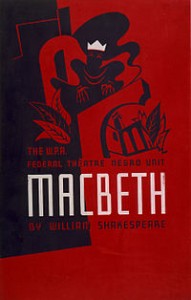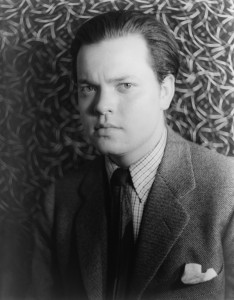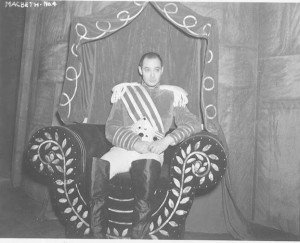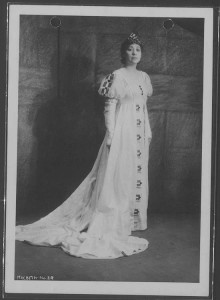
HAPPY FRIDAY P.O.U!
We continue our series on Black Shakespearean Actors…
“VOODOO MACBETH”

The Voodoo Macbeth is a common nickname[1] for the Federal Theatre Project’s 1936 New York production of William Shakespeare’s Macbeth, featuring an all-African American cast directed by Orson Welles. The production relocated the setting of the play from Scotland to a fictional Caribbean island based on Haiti, and acquired its nickname due to its use of voodoo imagery in place of the witchcraft in the original play.[2] A box-office sensation, the production is regarded as a landmark theatrical event for several reasons: its innovative interpretation of the play, its success in promoting African-American theatre, and its role in securing the reputation of its 20-year-old director.
Background

The Works Project Administration was an attempt at an economic stimulus during the Great Depression, under its aegis was Federal Project Number One responsible for generating jobs in the arts for which the Federal Theater Project was created. At the lobbying of civil rights activists[citation needed] a Negro Theater Unit was created. It was split into two halves, the “Contemporary Branch” to create theatre on contemporary black issues, and the “Classic Branch”, to perform classic drama.[3] The aim was to provide a point of entry into the theatre workforce for black actors and stagehands, and to raise community pride by performing classic plays without reference to the colour of the actors.[4]
Concept

Shakespeare’s play is about the downfall of a usurper in medieval Scotland, who is encouraged in his actions by three witches. The central idea behind Welles’s production was to perform the text straight, but to use costumes and sets that alluded to Haiti in the 19th century, specifically during the reign of the slave-turned-emperor Henri Christophe.[5] Although the main reason for this choice was that it was an appropriate setting for an all-black cast, Welles felt that it also enhanced the play’s realism: he thought the production’s popularity was partly due to the fact that the idea of voodoo was more credible to a contemporary audience than was medieval witchcraft.[6]
In many productions, the character of Hecate, the Queen of the Witches, is often cut. Instead, Welles turned the character into a pivotal figure. Performed by Eric Burroughs as a huge man with a bullwhip,[7] Hecate ended the play with the line “The charm’s wound up”, transferred from Act 1.[8] Welles’s 1948 film version of Macbeth, in which Hecate does not appear, also ends with this line.
The production used a single, unchanging set of a castle in a jungle. The backdrops featured stylized palm trees and skeleton imagery.[9]

It is not certain whether the production removed references to Scotland from the text. Welles’s promptbook keeps them intact, but in the surviving film record of the production’s climax, the line “Hail, King of Scotland” is truncated to “Hail, King”.[10]
Production
The leadership roles in the Negro Theater Unit were all white. John Houseman, the director of the NTP, invited the young white director Orson Welles to direct a production of Macbeth.[11] Welles was only 20, but was already a major radio star, and seized the opportunity to prove himself as a promising director.[12] The designer was Nat Karson.[13] The lighting was created by Abe Feder, one of the first full-time lighting designers.[14] Feder had a difficult relationship with Welles, whom he believed was too young and ignorant of the practicalities of theatre; he continued to hold this opinion when interviewed decades later.[15]
Since the production’s hierarchy was inherently racist, Welles also faced some difficulties in asserting authority with the black cast and crew, who were “not accustomed to being bossed around by preppy young whites”.[8] However, Welles won over the cast with his youthful energy and his warmth.[8] Black cast and crew members interviewed decades later said that they felt included in the creative process.[3] Welles, who was wealthy from his radio work, pleased everyone by cramming the rehearsal space with food and drink.[16]
The production opened at the Lafayette Theatre in Harlem. It then had a brief run on Broadway at the Adelphi Theatre, before touring local high schools.[17] It then toured the country, including performances in Bridgeport, Hartford, Dallas, Indianapolis, Chicago, Detroit, Cleveland, and finally returning to New York at the Majestic Theatre in Brooklyn (October 4–17).[18] A few minutes of the production can be seen in the 1937 film We Work Again, a U.S. government documentary about the work projects.[19] The film, which is now in the public domain, can be viewed online.[20] The production was invited to London, but Welles declined, because he was trying to secure his career in New York.[21]
Cast
The entire cast and crew numbered over one hundred people, but only five of them were professional actors.[22] Welles cast Jack Carter as Macbeth and Edna Thomas as Lady Macbeth. Both were light-skinned, and wore dark makeup in order to avoid looking different from the rest of the cast.[23] Thomas played Lady Macbeth as a mother figure to Macbeth.[24] Canada Lee played Banquo.[7] Lee had met Welles prior to his involvement with the production, at a performance of Stevedore. The audience had been whipped into a frenzied shouting match, and Lee rescued Welles from being attacked by another audience member wielding a knife.[25]
Carter was a former criminal and an alcoholic, but Welles cast him despite being warned of his habit of disappearing for weeks on binges. Carter understood the importance of the production to his career, and kept his drinking under control during the Harlem run.[26] Welles expended a great deal of time on helping Carter channel his adrenalin into a solid performance.[27] The two men bonded, and would hit the nightspots of Harlem together after rehearsals.[28] However, his behavior became so problematic that he had to be replaced, by the performer of MacDuff, Maurice Ellis, during the show’s Broadway run (Ellis’s performance is the one recorded on film).[23] Welles would later claim to have played Macbeth himself in blackface, after Ellis fell ill one night on tour in Indianapolis.
There were few professional African-American actors available and many of the cast members had never acted in Shakespeare before. Welles believed, however, that they showed a better understanding of the rhythm of the iambic pentameter than many professionals.[24]
Welles also hired a team of African drummers, some of whom were knowledgeable about voodoo practices, to accompany the witch’s speeches with drumbeats.[29] They were led by Sierra Leonean drummer Asadata Dafora.[22]
Responses
Before the production opened, the Harlem Communists tried to agitate the community against the project, wrongly believing that Welles had cast black actors in order to create a comic or burlesque version of Shakespeare. The theatre was picketed throughout rehearsals. One man attempted to slash Welles’s face with a razor, but Canada Lee, a former boxer, stopped him.[30]
According to Welles, the anger was suddenly replaced “for no reason at all” by widespread excitement and pride in the community as the opening night approached.[31] The “Voodoo Macbeth” defied all expectations, becoming a box-office sensation. Seventh Avenue had to be closed for 10 blocks on either side of the theatre and the opening night played to a packed house, and continued to do so for nine weeks.[32]
Most reviewers, including those from the New York Times and the New York Daily News loved the production, praising its energy and excitement. However, Carter was criticized for poor verse delivery, and for seeming more interested in displaying his physique than acting. One reviewer, Percy Hammond of the Herald Tribune, was negative about the entire cast, accusing the actors of being inaudible and timid. In response, one of the African drummers created a voodoo doll of Hammond, stuck pins in it, and encouraged Welles to take responsibility for any torments Hammond suffered as a result. Welles says he found this amusing, until Hammond died shortly afterward.[33]
(SOURCE: Wikipedia)
Newsreel of “Voodoo Macbeth”
